KIA Spectra 2009 2.G Manual PDF
Manufacturer: KIA, Model Year: 2009, Model line: Spectra, Model: KIA Spectra 2009 2.GPages: 291, PDF Size: 2.63 MB
Page 71 of 291
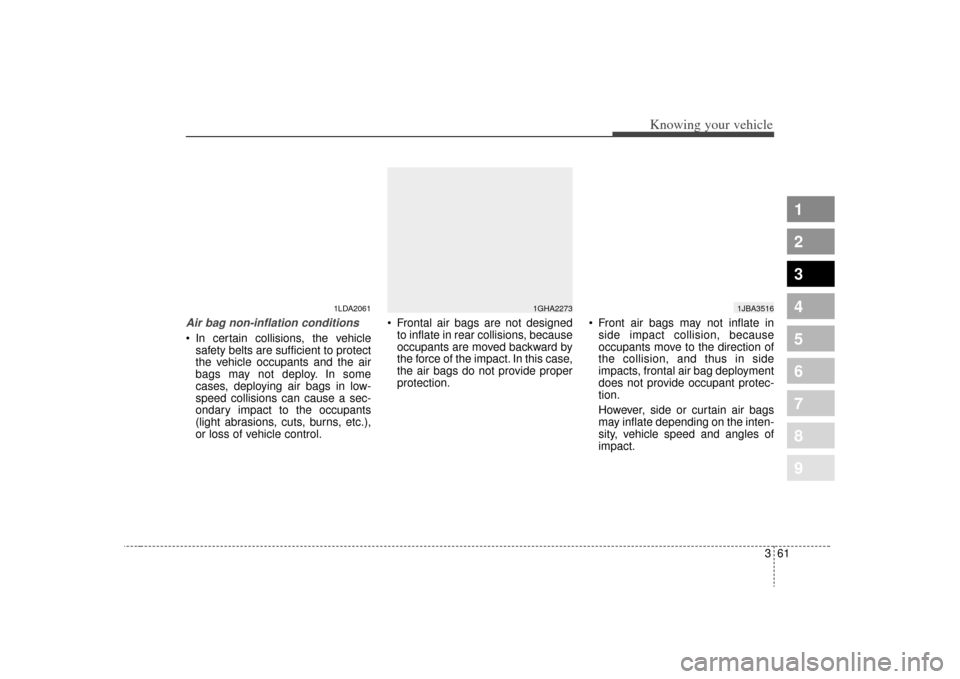
361
1
2
3
4
5
6
7
8
9
Knowing your vehicle
Air bag non-inflation conditions In certain collisions, the vehiclesafety belts are sufficient to protect
the vehicle occupants and the air
bags may not deploy. In some
cases, deploying air bags in low-
speed collisions can cause a sec-
ondary impact to the occupants
(light abrasions, cuts, burns, etc.),
or loss of vehicle control. Frontal air bags are not designed
to inflate in rear collisions, because
occupants are moved backward by
the force of the impact. In this case,
the air bags do not provide proper
protection. Front air bags may not inflate in
side impact collision, because
occupants move to the direction of
the collision, and thus in side
impacts, frontal air bag deployment
does not provide occupant protec-
tion.
However, side or curtain air bags
may inflate depending on the inten-
sity, vehicle speed and angles of
impact.
1GHA2273
1LDA2061
1JBA3516
Page 72 of 291

Knowing your vehicle62
3
1
2
3
4
5
6
7
8
9
In a slant impact or collision, the
force delivered will be relatively
weaker than that of frontal colli-
sion. So, the air bags may not
inflate. At the moment of an accident, driv-
ers often brake heavily with reflex.
In such heavy braking, the front
portion of the vehicle is lowered by
the force of the braking and the
vehicle can dive under a vehicle
with a higher ground clearance. Air
bags may not inflate in this situa-
tion because impacts may not be
delivered or may be delivered with
less intensity. Air bags may not inflate in rollover
accidents because air bag deploy-
ment would not provide proper pro-
tection to the occupants.
However, side air bags may inflate
when the vehicle is rolled over by a
side impact collision, if the vehicle
is equipped with side air bags and
curtain air bags.
1GHA2270
1LDA2065
1LDA2066
Page 73 of 291
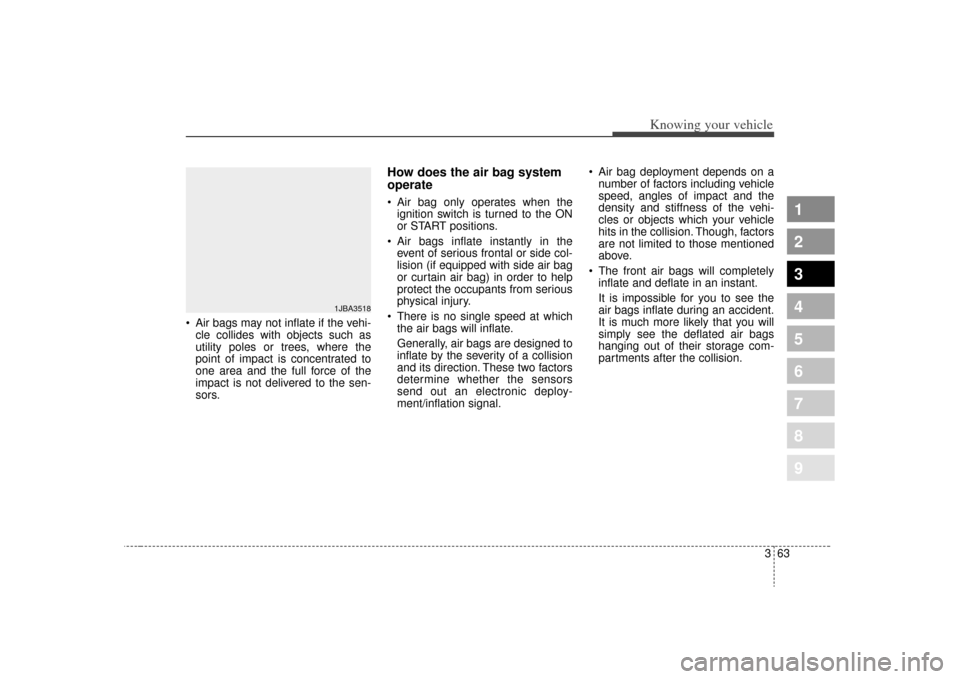
363
1
2
3
4
5
6
7
8
9
Knowing your vehicle
Air bags may not inflate if the vehi-cle collides with objects such as
utility poles or trees, where the
point of impact is concentrated to
one area and the full force of the
impact is not delivered to the sen-
sors.
How does the air bag system
operate Air bag only operates when theignition switch is turned to the ON
or START positions.
Air bags inflate instantly in the event of serious frontal or side col-
lision (if equipped with side air bag
or curtain air bag) in order to help
protect the occupants from serious
physical injury.
There is no single speed at which the air bags will inflate.
Generally, air bags are designed to
inflate by the severity of a collision
and its direction. These two factors
determine whether the sensors
send out an electronic deploy-
ment/inflation signal. Air bag deployment depends on a
number of factors including vehicle
speed, angles of impact and the
density and stiffness of the vehi-
cles or objects which your vehicle
hits in the collision. Though, factors
are not limited to those mentioned
above.
The front air bags will completely inflate and deflate in an instant.
It is impossible for you to see the
air bags inflate during an accident.
It is much more likely that you will
simply see the deflated air bags
hanging out of their storage com-
partments after the collision.
1JBA3518
Page 74 of 291

Knowing your vehicle64
3
1
2
3
4
5
6
7
8
9
In order to help provide protection
in a severe collision, the air bags
must inflate rapidly. The speed of
air bag inflation is a consequence
of the extremely short time in which
a collision occurs and the need to
get the air bag between the occu-
pant and the vehicle structures
before the occupant impacts those
structures. This speed of inflation
reduces the risk of serious or life-
threatening injuries in a severe col-
lision and is thus a necessary part
of air bag design.
However, air bag inflation can also
cause injuries which normally can
include facial abrasions, bruises
and broken bones, and sometimes
more serious injuries because the
inflation speed also causes the air
bags to expand with a great deal of
force.
There are even circumstances under which contact with the
steering wheel air bag can cause
fatal injuries, especially if the
occupant is positioned exces-
sively close to the steering
wheel.
Noise and smokeWhen the air bags inflate, they make
a loud noise and they leave smoke
and powder in the air inside of the
vehicle. This is normal and is a result
of the ignition of the air bag inflator.
After the air bag inflates, you may
feel substantial discomfort in breath-
ing due to the contact of your chest
to both the safety belt and the air
bag, as well as from breathing the
smoke and powder. We strongly
urge you to open your doors
and/or windows as soon as possi-
ble after impact in order to reduce
discomfort and prevent prolonged
exposure to the smoke and pow-
der.
Though smoke and powder are non-
toxic, it may cause irritation to the
skin (eyes, nose and throat etc).
Wash and rinse with the cold water
immediately and consult the doctor if
the symptom persists.
WARNING
To avoid severe personal injury or death caused by
deploying air bags in a colli-
sion, the driver should sit as
far back from the steering
wheel air bag as possible (at
least 250 mm (10 inches)
away). The front passenger
should always move their seat
as far back as possible and sit
back in their seat.
Air bag inflates instantly in an event of collision, passengers
may be injured by the air bag
expansion force if they are not
in proper position.
Air bag inflation may cause injuries which normally
include facial or bodily abra-
sions, injuries by the broken
glasses or burns by the explo-
sives.
Page 75 of 291
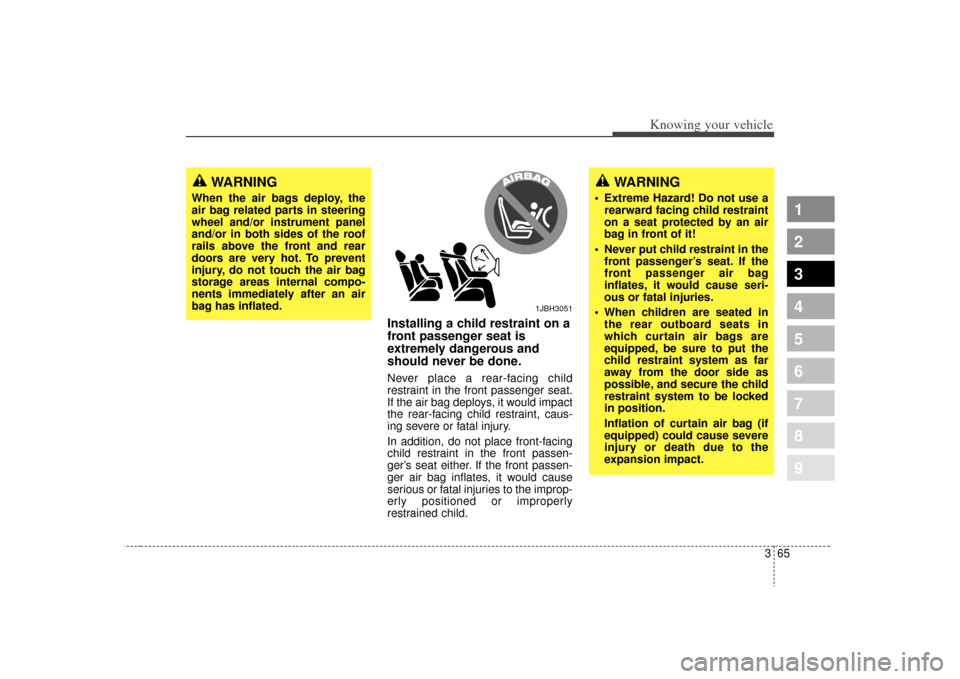
365
1
2
3
4
5
6
7
8
9
Knowing your vehicle
Installing a child restraint on a
front passenger seat is
extremely dangerous and
should never be done.Never place a rear-facing child
restraint in the front passenger seat.
If the air bag deploys, it would impact
the rear-facing child restraint, caus-
ing severe or fatal injury.
In addition, do not place front-facing
child restraint in the front passen-
ger’s seat either. If the front passen-
ger air bag inflates, it would cause
serious or fatal injuries to the improp-
erly positioned or improperly
restrained child.
WARNING
Extreme Hazard! Do not use arearward facing child restraint
on a seat protected by an air
bag in front of it!
Never put child restraint in the front passenger’s seat. If the
front passenger air bag
inflates, it would cause seri-
ous or fatal injuries.
When children are seated in the rear outboard seats in
which curtain air bags are
equipped, be sure to put the
child restraint system as far
away from the door side as
possible, and secure the child
restraint system to be locked
in position.
Inflation of curtain air bag (if
equipped) could cause severe
injury or death due to the
expansion impact.
WARNING
When the air bags deploy, the
air bag related parts in steering
wheel and/or instrument panel
and/or in both sides of the roof
rails above the front and rear
doors are very hot. To prevent
injury, do not touch the air bag
storage areas internal compo-
nents immediately after an air
bag has inflated.
1JBH3051
Page 76 of 291
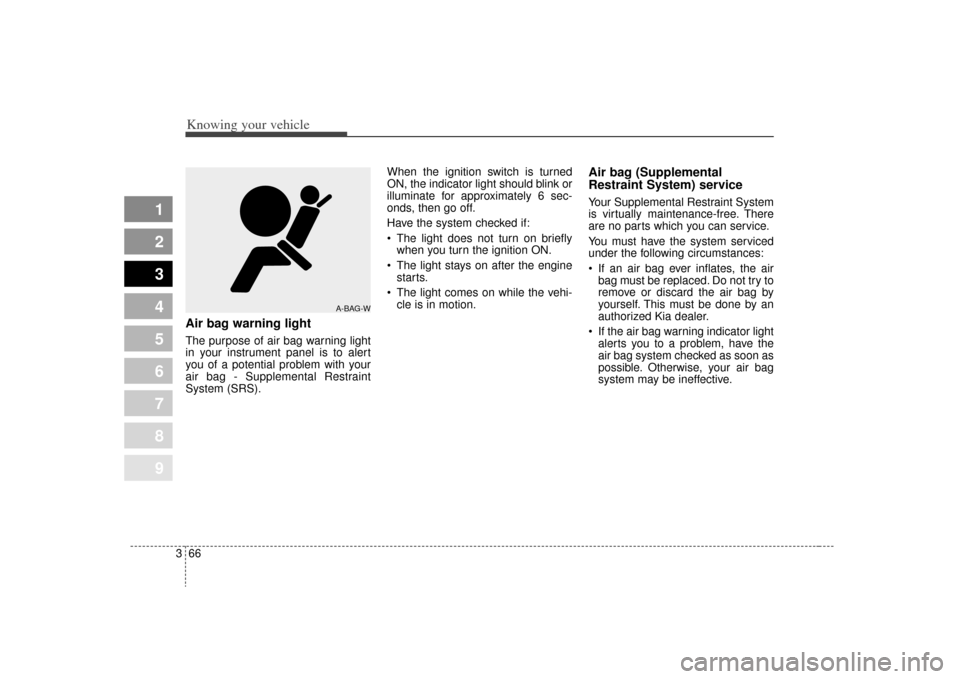
Knowing your vehicle66
3
1
2
3
4
5
6
7
8
9
Air bag warning lightThe purpose of air bag warning light
in your instrument panel is to alert
you of a potential problem with your
air bag - Supplemental Restraint
System (SRS). When the ignition switch is turned
ON, the indicator light should blink or
illuminate for approximately 6 sec-
onds, then go off.
Have the system checked if:
The light does not turn on briefly
when you turn the ignition ON.
The light stays on after the engine starts.
The light comes on while the vehi- cle is in motion.
Air bag (Supplemental
Restraint System) service Your Supplemental Restraint System
is virtually maintenance-free. There
are no parts which you can service.
You must have the system serviced
under the following circumstances:
If an air bag ever inflates, the airbag must be replaced. Do not try to
remove or discard the air bag by
yourself. This must be done by an
authorized Kia dealer.
If the air bag warning indicator light alerts you to a problem, have the
air bag system checked as soon as
possible. Otherwise, your air bag
system may be ineffective.
A-BAG-W
Page 77 of 291

367
1
2
3
4
5
6
7
8
9
Knowing your vehicle
Repairing or scrapping the vehi-cles Repairing steering wheel, instru- ment panel, center console or
roofs, or installing car audio around
center console or painting front
metal sheet could disable the air
bag system. Have them checked
by an authorized Kia dealer.
When leaving the vehicle at an authorized Kia dealer, inform the
facility that the vehicle is equipped
with air bag system, and leave the
owner’s manual in the vehicle.
Since air bag system contains explosive chemical substances,
contact an authorized Kia dealer
when scrapping the vehicle.
CAUTION
Do not modify any part of theSupplemental Restraint System.Modification could make the airbag system ineffective or couldcause unnecessary deploy-ment.
WARNING
Do not modify your steering wheel, seat or any other part
of the Supplemental Restraint
System. Modification could
make the system inoperable.
Do not work on the system’s components or wiring. This
could cause the air bags to
inflate inadvertently, possibly
seriously injuring someone.
Working on the system could
also disable the system so
that the air bags would not
deploy in a collision.
Any work on the SRS system, such as removing, installing,
repairing, or any work on the
steering wheel must be per-
formed by a qualified Kia tech-
nician. Improper handling of
the air bag system may result
in serious personal injury or
death.
Page 78 of 291
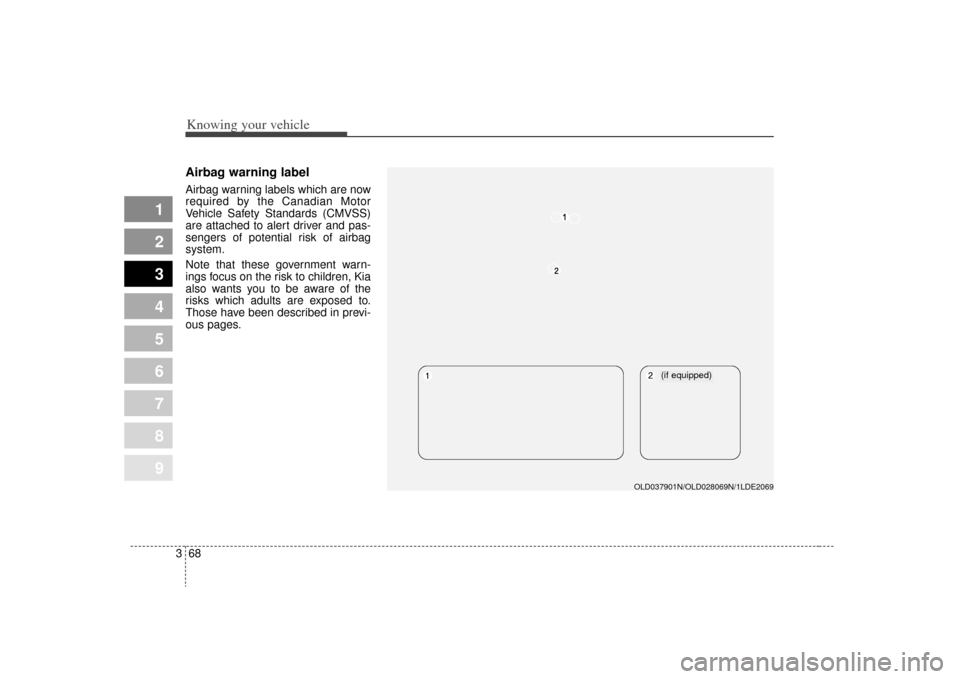
Knowing your vehicle68
3
1
2
3
4
5
6
7
8
9
Airbag warning labelAirbag warning labels which are now
required by the Canadian Motor
Vehicle Safety Standards (CMVSS)
are attached to alert driver and pas-
sengers of potential risk of airbag
system.
Note that these government warn-
ings focus on the risk to children, Kia
also wants you to be aware of the
risks which adults are exposed to.
Those have been described in previ-
ous pages.
OLD037901N/OLD028069N/1LDE2069
(if equipped)
Page 79 of 291
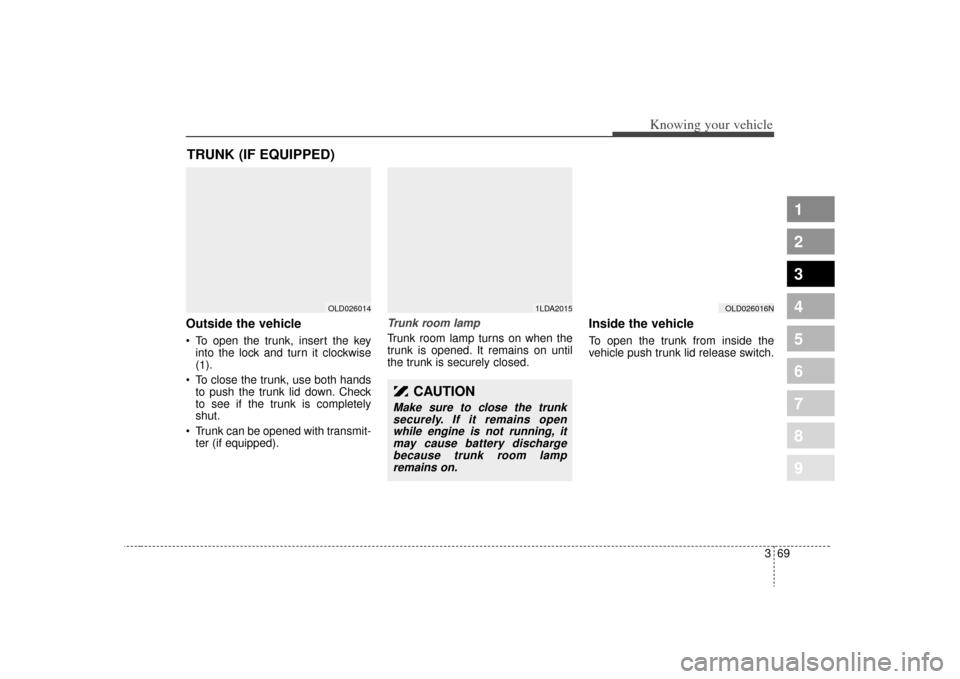
369
1
2
3
4
5
6
7
8
9
Knowing your vehicle
Outside the vehicle To open the trunk, insert the keyinto the lock and turn it clockwise
(1 ).
To close the trunk, use both hands to push the trunk lid down. Check
to see if the trunk is completely
shut.
Trunk can be opened with transmit- ter (if equipped).
Trunk room lampTrunk room lamp turns on when the
trunk is opened. It remains on until
the trunk is securely closed.
Inside the vehicleTo open the trunk from inside the
vehicle push trunk lid release switch.
TRUNK (IF EQUIPPED)
1LDA2015
OLD026014
CAUTION
Make sure to close the trunksecurely. If it remains openwhile engine is not running, itmay cause battery dischargebecause trunk room lampremains on.
OLD026016N
Page 80 of 291

Knowing your vehicle70
3
1
2
3
4
5
6
7
8
9
Emergency trunk safety
release (if equipped)Your vehicle is equipped with an
emergency trunk release cable locat-
ed inside the trunk. The lever glows
in the dark when the trunk lid is
closed. If someone is inadvertently
locked in the trunk, pulling this han-
dle will release the trunk latch mech-
anism and open the trunk.
WARNING
- Exhaust
fumes
If you drive with the trunk lid
open, you will draw dangerous
exhaust fumes into your vehicle
causing serious injury or death
to vehicle occupants. Open
trunk lids can also dangerously
obscure rear view vision.
If you must drive with the trunk
lid open, keep the air vents open
so that additional outside air
comes into the vehicle.
OLD026017
WARNING
No one should be allowed to
occupy the trunk of the vehicle
at any time. If the trunk is par-
tially or totally latched and the
person is unable to get out,
severe injury or death could
occur due to lack of ventilation,
exhaust fumes and rapid heat
build-up, or because of expo-
sure to cold weather conditions.
The trunk is also a highly dan-
gerous location in the event of a
crash because it is not a pro-
tected occupant space but
merely a part of the vehicle’s
crush zone.